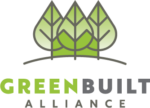Welcome to Western North Carolina, home of ancient mountains and rainforest conditions. If you build here, be ready for tight building schedules, limited budgets, and small steep lots. Builders need to be ready to get creative, stay clean, and keep from going over budget while solving the inescapable difficulties of building in our mountain valleys and slopes.
This is a case study on a West Asheville residential infill project where 2-1/2 acres of street runoff drain through a steep lot.
The water runs down Logan Avenue into the storm drain, which discharges from a culvert into a swale, or a contoured drainage basin, and then off the rear of the property onto the adjacent neighbor’s property.
On initial review of the proposed project, we expected to be able to build around the existing swale without disturbing it, but after some initial clearing by hand, it became evident that we were going to have to move the swale and seek professional guidance.
Russ Davis of RDA & Associates came up with a creative swale redesign, which utilizes sod as the swale liner. This is a nice design because it softens the swale by replacing the standard 6” – 12” rough granite of a standard swale design with soft green fescue. The grass effectively increases the limited yard area and reduces the overall cost of material and installation.
With the design established, execution was our next step. Silt fences were installed along with some straw bales for redundant runoff protection. The grader, Mark McIntosh, removed some trees, filled and compacted the existing swale location, and dug the new swale path where it wouldn’t interfere with the home. After the site work was completed, our hope was to have sod onsite immediately to prevent washing dirt onto the neighbors’ property and into the stream. Unfortunately, the sod farms weren’t cutting due to rain. In order to keep the dirt dry, we purchased 6 mil plastic to line the swale. The crew rolled out the plastic and ballasted it with rocks. It promptly began raining, and rained for the next two weeks, which also meant no sod was being cut during that time. At the first opportunity, sod was delivered, and installation began at the bottom of the property. The sod was rolled out in a herringbone pattern with a 1”-2” overlap similar to roof shingles. The sod was then pinned together with landscape fabric pins to ensure that the sod would stay put long enough for the roots to establish themselves in their new location.
It has now been 4 months from install, and we have an appealing swale with established sod that hasn’t washed any soil from our site onto the neighbor’s property or into the stream.
Raymond Thompson owns and works for Sure Foot Builders. He fell in love with green building when he built his first home out of maple bark and has been trying to do it better ever since.
You can also view this article as it was originally published on page 58 of the 2015-2016 edition of the directory or as a pdf.

